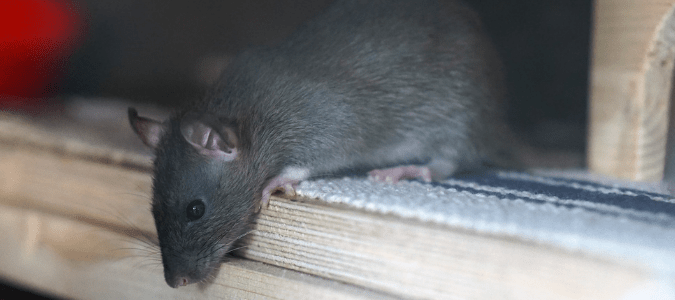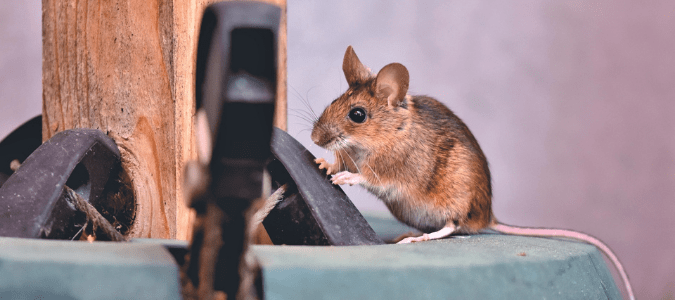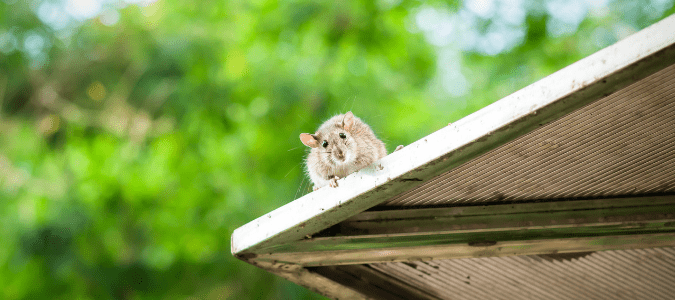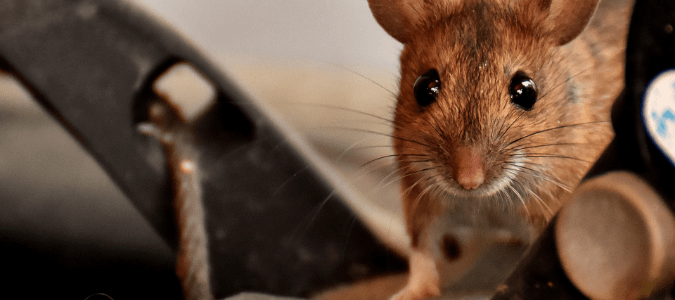How To Identify a Roof Rat Versus a Mouse

How to Identify a Roof Rat
Roof rats are brown or black in color, with smooth, scaly tails. They have pointy faces, and big eyes and ears. If you spot a rodent that fits this description, you might wonder how to tell if it’s a rat or a mouse.
The first and most noticeable difference between roof rats and mice is their size. A roof rat, which is pictured above, is about twice as big as a mouse. A full-grown mouse will grow to just a few inches long, not including the tail. A full-grown roof rat’s body, on the other hand, will be six to eight inches long. Its tail adds another six to seven inches!
Of course, knowing a rodent’s size only helps you identify it if you actually see the rodent. Most roof rats and mice are nocturnal. They’re also scared of humans, and good at staying out of sight. That means you may never see the pest itself. You’re more likely to see signs of its activity. One of the most common signs of rodent pest activity is their droppings.
Since a roof rat is so much bigger than a mouse, its droppings are also bigger. Roof rat poop is dark brown in color and pointed at the ends. Each pellet is around a centimeter long. You might spot rat poop anywhere in your home where rats spend time. There are some common places, however, where people typically spot rodent droppings. These include in the garage or basement, on top of cabinets, or inside a crawl space or a wall void.
Like lots of rodents, roof rats are opportunistic eaters. That means they can eat a wide variety of things, and will feed on whatever they can find. In nature, these rats feed on nuts, seeds and fruits. If you have nut- or fruit-bearing trees in your yard, these could be drawing roof rats to your property. These pests are food hoarders, so spotting piles of nuts or seeds could be another sign of roof rats living nearby.
Gnaw marks are another sign of rodent activity in and around the home. It’s harder to tell the exact type of rodent you’re dealing with from just these marks, though. All rats and mice have constantly growing front teeth that require daily gnawing to stay filed down. Gnaw marks are often visible on baseboards, cabinets, rafters or other wooden elements of the home, attic or garage. You might also see these marks on PVC piping.
Similarly, nesting materials can indicate a rodent nest nearby, but it’s hard to tell what type of rodent without other clues. Both rats and mice create nests out of materials they find and shred. They might use natural materials like sticks and leaves. They also might shred up fabric, paper or even fiberglass insulation.
Since rats and mice usually nest in hidden, interior spaces, such as within wall voids or crawl spaces, you might not ever see their nests. But if you come across a clump of shredded-up items, it could be from a roof rat’s nest. This is especially likely if you find the nest in a high-up place. Roof rats are good climbers, so they often nest in attics or rafters, on top of cabinets, or in other elevated spots.

How to Identify a House Mouse
House mice are much smaller rodents than roof rats. Adult mice usually grow to about three or four inches in length. Their furry tails may add another two to four inches. These rodents are usually brown or gray in color, but their fur may be so dark it looks almost black.
Mice leave much smaller droppings than roof rats. Their droppings are brown pellets, pointed at the ends, and about an eighth-inch to a quarter-inch long. Mice might leave droppings anywhere in or around your home. If they are nesting somewhere within your house, they might visit your kitchen for food and water. This means you might find their poop in your pantry, inside cabinets or under the kitchen sink.
Like roof rats, mice gnaw on whatever they can find to file down their front teeth. You might spot gnaw marks on food packages in your kitchen as well as on baseboards, rafters or PVC piping. Gnaw marks alone can rarely reveal which type of rodent made them.
Mice also build nests using similar materials to those that rats use for their nests. Outdoors, a mouse nest might be made of grass and leaves as well as other natural items they find, like feathers. Indoors, the nest might be made of these natural materials brought in from outside, along with fabric, paper, cardboard or insulation.
Whether you have mice or rats living on your property, they can be a danger to you and your loved ones in several different ways. First, both rats and mice are known to carry bacteria and diseases that can make people very sick. These include hantavirus, leptospirosis, salmonella and even plague.
These can be present even in rodent feces and urine, so coming into contact with these pests or their poop and pee can be dangerous for humans. Similarly, rats and mice contaminate the surfaces they touch. If you have mice visiting your kitchen at night to steal food, they will contaminate anything they touch. This includes your countertops and shelving as well as any food or food packaging they might munch on.
Rats and mice can also cause extensive property damage with their gnawing habits. They have even been known to chew through the plastic surrounding electrical wiring, which creates a fire hazard.
Many people find that trying to control rodents on their own just prolongs the issue. And, many home remedies like using dogs to keep mice away just don’t work. Rats and mice reproduce fast, so their nests keep growing while you try to figure out the best way to get rid of them. If you think you may have a rodent problem, whether rats or mice, it’s best to contact a pest control company for help.
A licensed pest control professional can devise a customized approach to treating your infestation. They’ll use their extensive knowledge of rodent behavior along with specialized products and techniques to resolve your pest problem.

Where Do Roof Rats Live During the Day?
If you have a roof rat problem on your property, you may never actually see the rats themselves. Rats are nocturnal, meaning they are mostly active at night. So where do roof rats live during the day? The answer is likely to be that they are asleep in their nests.
This is because rats spend their nighttime hours looking for food. They might also use the cover of darkness to search for materials to use in building their nests. That’s a lot of activity, so they usually sleep in their nests all day.
Roof rats got their name from their tendency to build nests in high-up places. They often nest in attics or garage rafters, or in the interior spaces above ceilings. If rats build a nest someplace inside your house, you might hear scratching or squeaking sounds coming from within the walls or ceiling. If you have pets, they might also signal the presence of rodents by staring with high interest at a certain spot on the wall or ceiling.
Sometimes, rats or mice die inside the walls or ceiling. This produces a terrible smell that takes days or even weeks to go away as the body decomposes. In some cases, when there is a major rodent infestation, the pests urinate so much inside the walls or ceilings that their urine ends up soaking through the drywall. This will also smell bad, and will cause a discolored stain. If you have any of these signs of rats in your ceiling, it’s a good idea to contact professional help.

How to Seal House from Mice
It’s important to know how to seal your house from mice if you want to keep these pests away. While there are home remedies, like using moth balls to keep mice away, these methods aren’t proven to work. Mice get inside people’s houses through small openings leading into the house. These are often found around windows and exterior doors or in their screens. Mice can also use gaps around exterior vents or faucets to access the interior of your home. If your home has a pier-and-beam foundation, mice can get inside by following water pipes or finding small openings that lead up through the flooring.
Keeping mice out of your house involves finding these small openings and sealing them off. Keep in mind that mice can squeeze through surprisingly tiny gaps—even just the width of a pencil. Depending on where the opening is located, it can be closed off using caulk, wire mesh or steel wool.
Hiring a pest control professional to deal with a rodent infestation is a good idea for several reasons. Not only can a pest professional help to control rodents, but they can also schedule follow-up visits to make sure the pests stay away.
Chem-free Can Control the Rodents on Your Property
Having unwanted creatures on your property can make you and your family members uncomfortable. Chem-free can help. We can create a plan to control the pests on your property, so you can feel at ease again.
Need Help Managing Pests?
Chem-Free offers both effective, low-impact pest control options and preventative measures to help avoid future infestations. Contact us today for a free estimate!


